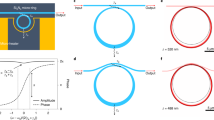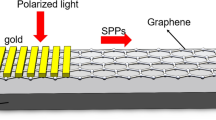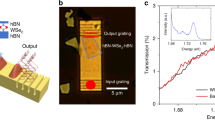Abstract
To keep pace with the demands in optical communications, electro-optic modulators should feature large bandwidths, operate across all telecommunication windows, offer a small footprint, and allow for CMOS-compatible fabrication to keep costs low1. Here, we demonstrate a new ultra-compact plasmonic phase modulator based on the Pockels effect in a nonlinear polymer. The device has a length of only 29 µm and operates at 40 Gbit s−1. Its modulation frequency response is flat up to 65 GHz and beyond. The modulator has been tested to work across a 120-nm-wide wavelength range centred at 1,550 nm, and is expected to work beyond this range. Its operation has been verified for temperatures up to 85 °C and it is easy to fabricate. To the best of our knowledge, this is the most compact high-speed phase modulator demonstrated to date.
This is a preview of subscription content, access via your institution
Access options
Subscribe to this journal
Receive 12 print issues and online access
$209.00 per year
only $17.42 per issue
Buy this article
- Purchase on Springer Link
- Instant access to full article PDF
Prices may be subject to local taxes which are calculated during checkout





Similar content being viewed by others
References
Reed, G. T., Mashanovich, G., Gardes, F. Y. & Thomson, D. J. Silicon optical modulators. Nature Photon. 4, 518–526 (2010).
Leuthold, J. et al. Silicon–organic hybrid electro-optical devices. IEEE J. Sel. Top. Quantum Electron. 19, 3401413 (2013).
Xu, Q., Schmidt, B., Pradhan, S. & Lipson, M. Micrometre-scale silicon electro-optic modulator. Nature 435, 325–327 (2005).
Watts, M. & Trotter, D. Ultralow power silicon microdisk modulators and switches. 5th IEEE International Conference on Group IV Photonics 4–6 (2008).
Dong, P., Liao, S., Feng, D., Liang, H. & Zheng, D. Low Vpp, ultralow-energy, compact, high-speed silicon electro-optic modulator. Opt. Express 17, 22484–22490 (2009).
Baba, T. et al. 50-Gb/s ring-resonator-based silicon modulator. Opt. Express 21, 11869–11876 (2013).
Thomson, D. J. et al. Self-aligned silicon ring resonator optical modulator with focused ion beam error correction. J. Opt. Soc. Am. B 30, 445–449 (2013).
Nguyen, H. C., Hashimoto, S., Shinkawa, M. & Baba, T. Compact and fast photonic crystal silicon optical modulators. Opt. Express 20, 22465–22474 (2012).
Liao, L. et al. 40 Gbit s−1 silicon optical modulator for high-speed applications. Electron. Lett. 43, 1196–1197 (2007).
Green, W. M., Rooks, M. J., Sekaric, L. & Vlasov, Y. A. Ultra-compact, low RF power, 10 Gbit s−1 silicon Mach–Zehnder modulator. Opt. Express 15, 17106–17113 (2007).
Thomson, D. J. et al. 50-Gb/s silicon optical modulator. Photon. Technol. Lett. 24, 234–236 (2012).
Xiao, X. et al. High-speed, low-loss silicon Mach–Zehnder modulators with doping optimization. Opt. Express 21, 4116–4125 (2013).
Ding, R. et al. Demonstration of a low VπL modulator with GHz bandwidth based on electro-optic polymer-clad silicon slot waveguides. Opt. Express 18, 15618–15623 (2010).
Brosi, J. M. et al. High-speed low-voltage electro-optic modulator with a polymer-infiltrated silicon photonic crystal waveguide. Opt. Express 16, 4177–4191 (2008).
Alloatti, L. et al. 42.7 Gbit s−1 electro-optic modulator in silicon technology. Opt. Express 19, 11841–11851 (2011).
Raether, H. Surface Plasmons on Smooth and Rough Surfaces and on Gratings (Springer, 1988).
Maier, S. Plasmonics: Fundamentals and Applications (Springer, 2007).
Schuller, J. A. et al. Plasmonics for extreme light concentration and manipulation. Nature Mater. 9, 193–204 (2010).
Gramotnev, D. K. & Bozhevolnyi, S. I. Plasmonics beyond the diffraction limit. Nature Photon. 4, 83–91 (2010).
Kauranen, M. & Zayats, A. V. Nonlinear plasmonics. Nature Photon. 6, 737–748 (2012).
Fang, Z. et al. Graphene–antenna sandwich photodetector. Nano Lett. 12, 3808–3813 (2012).
Nikolajsen, T., Leosson, K. & Bozhevolnyi, S. I. Surface plasmon polariton based modulators and switches operating at telecom wavelengths. Appl. Phys. Lett. 85, 5833–5835 (2004).
Schildkraut, J. Long-range surface plasmon electrooptic modulator. Appl. Opt. 27, 4587–4590 (1988).
Cai, W., White, J. & Brongersma, M. Compact, high-speed and power-efficient electrooptic plasmonic modulators. Nano Lett. 9, 4403–4411 (2009).
Randhawa, S. et al. Performance of electro-optical plasmonic ring resonators at telecom wavelengths. Opt. Express 20, 2354–2362 (2012).
Dionne, J. A., Diest, K., Sweatlock, L. A. & Atwater, H. A. PlasMOStor: a metal–oxide–Si field effect plasmonic modulator. Nano Lett. 9, 897–902 (2009).
Melikyan, A. et al. Surface plasmon polariton absorption modulator. Opt. Express 19, 8855–8869 (2011).
Sorger, V. J., Lanzillotti-Kimura, N. D., Ma, R.-M. & Zhang, X. Ultra-compact silicon nanophotonic modulator with broadband response. Nanophotonics 1, 17–22 (2012).
Feigenbaum, E., Diest, K. & Atwater, H. A. Unity-order index change in transparent conducting oxides at visible frequencies. Nano Lett. 10, 2111–2116 (2010).
Pile, D. F. P. & Gramotnev, D. K. Adiabatic and nonadiabatic nanofocusing of plasmons by tapered gap plasmon waveguides. Appl. Phys. Lett. 89, 041111 (2006).
Boyd, R. W. Nonlinear Optics (Academic, 2008).
Johnson, P. & Christy, R. Optical constants of the noble metals. Phys. Rev. B 6, 4370–4379 (1972).
Jin, D. et al. EO polymer modulators reliability study. Proc. SPIE Org. Photon. Mater. Dev. XII 7599, 75990H (2010).
Schmogrow, R. et al. Error vector magnitude as a performance measure for advanced modulation formats. IEEE Photonic. Tech. Lett. 24, 61–63 (2012); correction 24, 2198 (2012).
Zheng, X. et al. Energy-efficient error control for tightly coupled systems using silicon photonic interconnects. J. Opt. Commun. Netw. 3, A21 (2011).
Miller, D. A. B. Energy consumption in optical modulators for interconnects. Opt. Express 20, A293–A308 (2012).
Palmer, R. et al. High-speed silicon-organic hybrid (SOH) modulator with 1.6 fJ bit−1 and 180 pm V−1 in-device nonlinearity, in ECOC London 2013, paper We3B3.
Acknowledgements
The authors acknowledge support from EU research projects NAVOLCHI and SOFI, the Helmholtz International Research School for Teratronics (HIRST), the Karlsruhe School of Optics & Photonics (KSOP), the Center for Functional Nanostructures (CFN), the German Research Foundation (DFG) and Karlsruhe Nano Micro Facility (KNMF). Silicon-on-insulator waveguides were fabricated by IMEC in the framework of ePIXfab.
Author information
Authors and Affiliations
Contributions
A.Me. developed the concept, designed and fabricated the modulators, performed the experiments, analysed the data and wrote the paper. L.A. built the poling equipment, and developed the poling procedure and the experimental method to estimate the modulation index. D.H., P.C.S., J.L. and R.P. performed the experiments. D.K. helped in designing the passive silicon platform. B.C. and R.D. developed and synthesized the M3 nonlinear polymer. A.Mu., D.V.T. and M.S. provided support in fabrication. M.K., C.K., W.F. and J.L. developed the concept, designed the experiment and wrote the manuscript.
Corresponding authors
Ethics declarations
Competing interests
The authors declare no competing financial interests.
Supplementary information
Supplementary information
Supplementary information (PDF 701 kb)
Rights and permissions
About this article
Cite this article
Melikyan, A., Alloatti, L., Muslija, A. et al. High-speed plasmonic phase modulators. Nature Photon 8, 229–233 (2014). https://doi.org/10.1038/nphoton.2014.9
Received:
Accepted:
Published:
Issue Date:
DOI: https://doi.org/10.1038/nphoton.2014.9
This article is cited by
-
Dynamic light manipulation via silicon-organic slot metasurfaces
Nature Communications (2024)
-
Ultra-compact exciton polariton modulator based on van der Waals semiconductors
Nature Communications (2024)
-
Nonlinear plasmonics: second-harmonic generation and multiphoton photoluminescence
PhotoniX (2023)
-
A multi-parameter tunable plasmon modulator
Scientific Reports (2023)
-
Integrated silicon photonic MEMS
Microsystems & Nanoengineering (2023)



